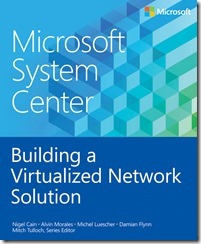 |
We’re happy to announce the next free ebook in our System Center series - Microsoft System Center: Building a Virtualized Network Solution
The book has been replaced by a Second Edition; learn more in this blog post.
Introduction
According to the Hyper-V Network Virtualization Overview found at https://technet.microsoft.com/en-us/library/jj134230.aspx, Network Virtualization “provides virtual networks to virtual machines similar to how server virtualization provides virtual machines to the operating system. Network Virtualization decouples virtual networks from the physical network infrastructure and removes the constraints and limitations of VLANs and hierarchical IP address assignment from virtual machine provisioning. This flexibility makes it easy for customers to move to Infrastructure as a Service (IaaS) clouds and efficient for hosters and datacenter administrators to manage their infrastructure while maintaining the necessary multi-tenant isolation, security requirements, and supporting overlapping Virtual Machine IP addresses.” Although the benefits of this approach are very clear, designing and implementing a solution that delivers the promised benefits is both complex and challenging; architects, consultants, and fabric administrators alike can often struggle to understand the different components and concepts that make up a solution.
Who should read this book?
Much of the published material covering Network Virtualization today is very much focused on the how, the set of tasks and things that you need to do (either in the console or through Windows PowerShell) to set up and configure the environment. In this book, we take a very different approach and instead, consider the what, with a view to helping private and hybrid cloud architects understand the overall architecture, the role each individual component plays, and the key decision points, design considerations, and the best practice recommendations they should adopt as they begin to design and build out a virtualized network solution based on Windows Server 2012 and Microsoft System Center 2012 SP1 (or later). In summary, this book is specifically designed for architects and cloud fabric administrators who want to understand what decisions they need to make during the design process and the implications of those decisions, what constitutes best practice, and, ultimately, what they need to do in order to build out a virtualized network solution that that meets today's business requirements while also providing a platform for future growth and expansion. In writing this book, we assume that as architects and fabric administrators interested in Microsoft Network Virtualization you are familiar and have a good understanding of the networking features and capabilities of Windows Server 2012 Hyper-V and System Center 2012 SP1, together with the Microsoft Cloud OS vision available at Experience Microsoft Cloud OS Vision page. |
